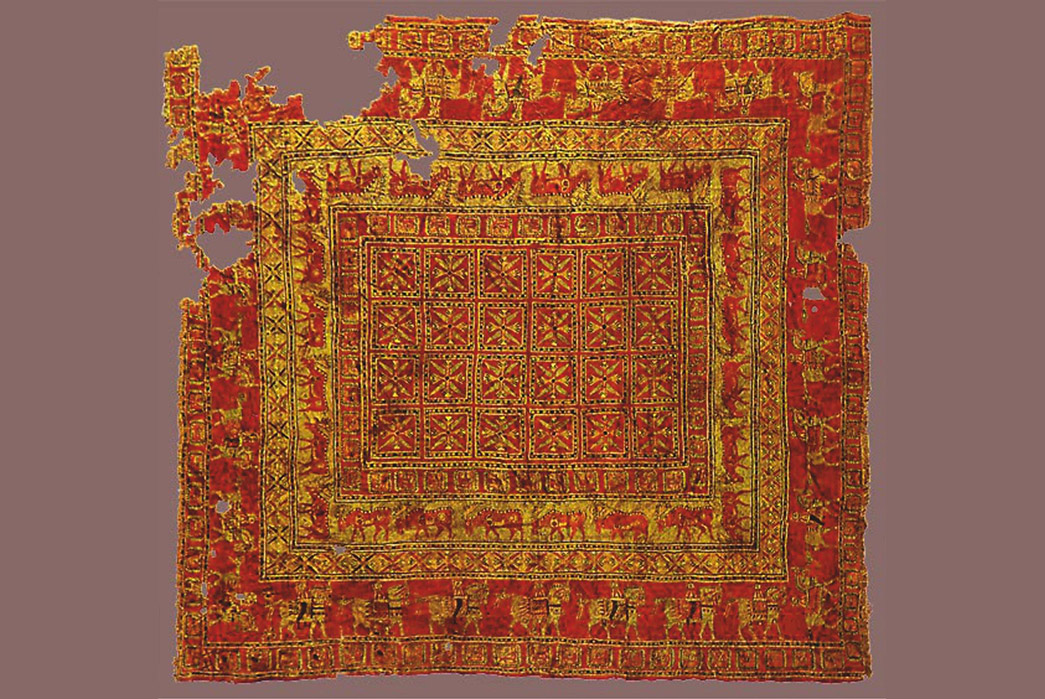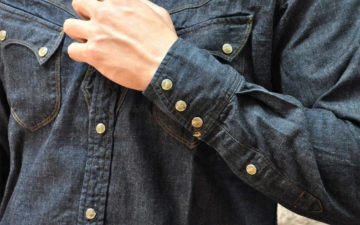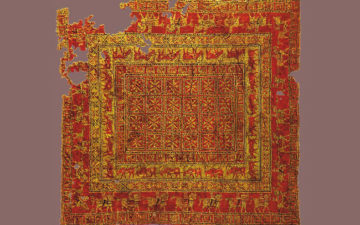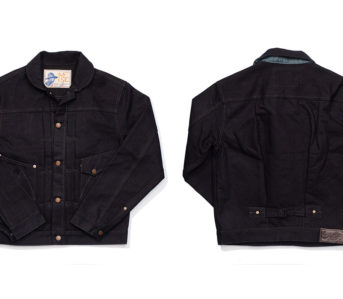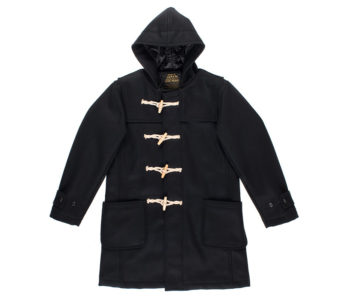In the city of Ctesiphon, a city along the banks of the Tigris river, not far from modern-day Baghdad, there lay one of the world’s greatest treasures. A modern audience would certainly have appreciated the beauty of this treasure, but might not have been able to divine its worth. This treasure, claimed by Arab conquerors in the year 637 CE wasn’t gold jewelry or silver armor—it was a carpet.
“Springtime of Khosro”, as the carpet was called, was no mere floor covering, it was one of the greatest feats of textile work ever undertaken. It had been commissioned by king Khosro I and was made from silk. It had been designed so that in the dead of winter, the king, could walk amidst the bright colors of spring and imagine fairer seasons to come.
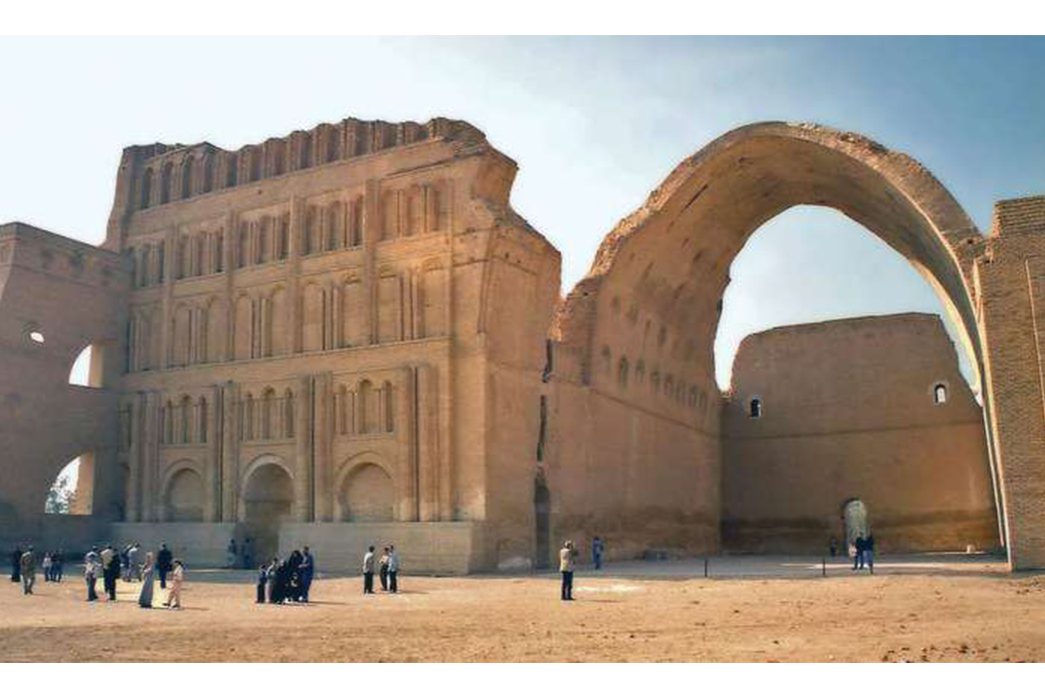
Cteisphon. Image via Britannica.
There was gold woven into the rug for the color of the earth, clear crystals for water, and a variety of precious stones. Size estimates vary, but the rug was anywhere between 90 and 200 square feet and weighed tons. This legendarily beautiful piece of art was promptly torn apart, to be given to the conquering troops as spoils of war, but its legacy lives on.
The desecration of Khosro’s carpet illustrates a couple things about the famous Persian Carpets. The first, that these were not mere floor coverings; they were the treasures of nations and works of art. Secondly, that their history is defined by war. Persia, a region that covers modern-day Iran and Iraq has been in a state of turmoil almost since the dawn of man.
The fertile lands fed by the famous Tigris and Euphrates rivers have been plundered by almost every leader from Alexander the Great to George W. Bush. The design of the carpets reflect this perpetual upheaval. Join us today for 2500 years of history and the story of the Persian Carpet.
Early Days
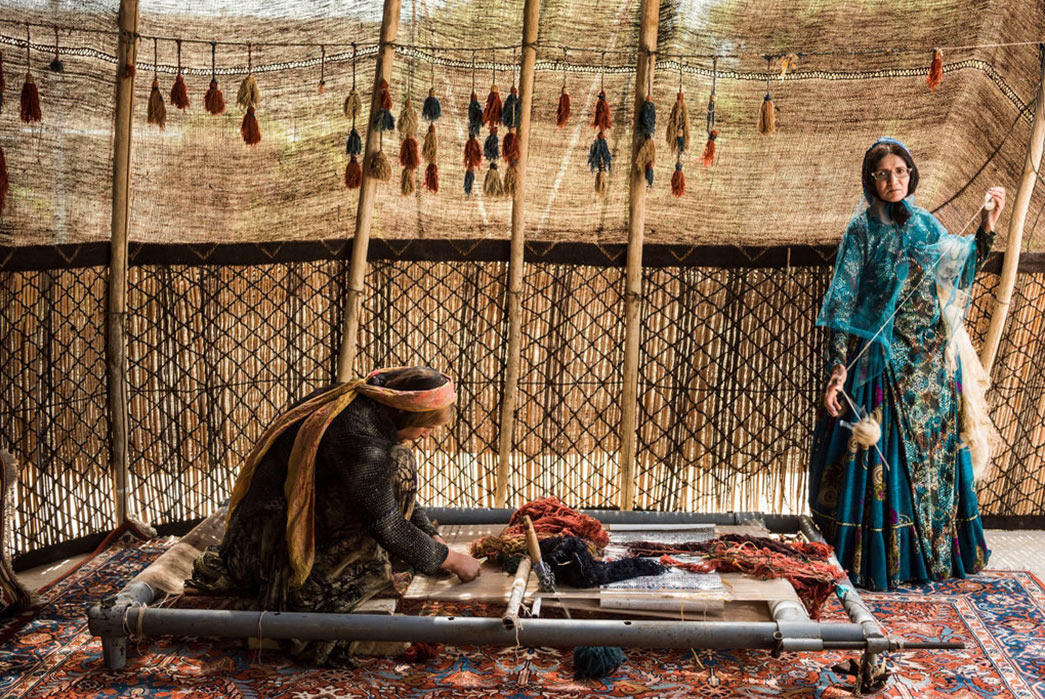
Modern day spinning and weaving. Image via NYtimes.
Tracing the history of this ancient art form isn’t easy. Textiles naturally degrade over time, so the earliest signs of these now-famous carpets are mainly in literature and in whorls found in archaeological sites. The first mentions of carpets from the middle-east are predominately in the record of conquerors.
Emperor Heraclius brought carpets back to Rome from the aforementioned city of Ctesiphon (a few years before the famous “Springtime in Khosro” was cut apart by Arab invaders) but unfortunately relics of this period haven’t survived. The oldest carpet in existence was found by Russian archaeologists in the Altai Mountains in Siberia, preserved for millennia in the frozen tombs of Scythian nobles. This particular carpet, shown earlier and below, was deduced to have come from the Archaemenids, an early Persian culture.
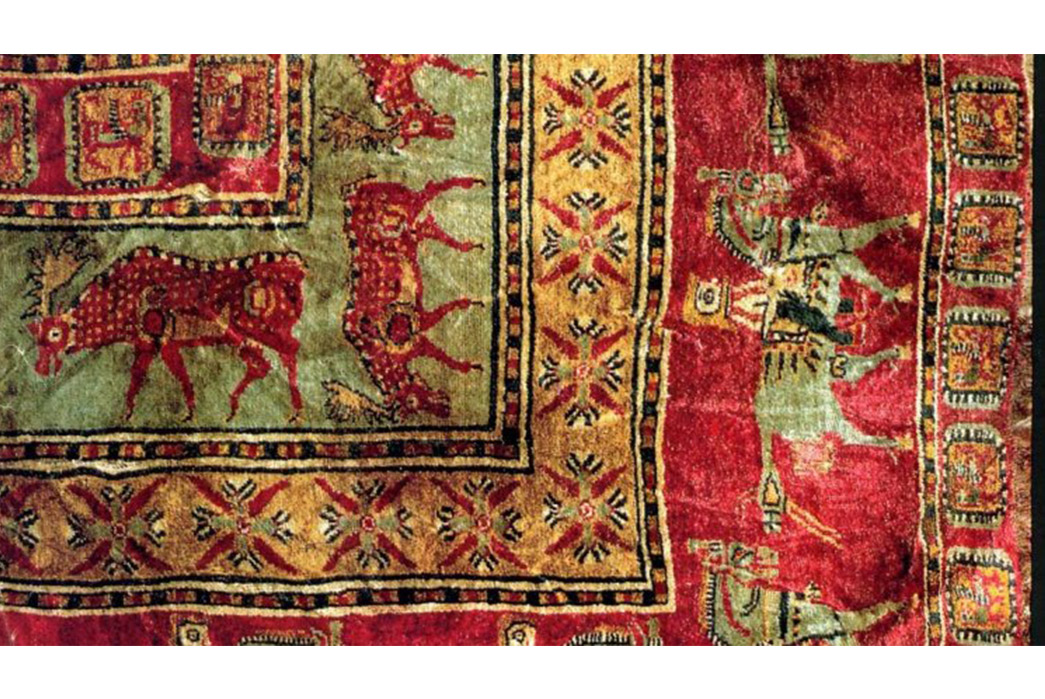
Closeup of Pazyryk Carpet, shown first above. Image via Financial Times.
When the first carpets emerged is hard to say or when nomads exchanged primitive animal pelt floor coverings for these intricate woven works of art is difficult to pinpoint, but it is easy to trace the history of the practice of carpet-making. Unless the pieces were kept at an extraordinarily low temperature and safe from insects and weather, these organic materials were eaten away.
What remains is typically the whorl: the weight for the famous drop spindle. Carpets disappear, yarn disappears, and so do the spindles that help spin the felt into yarn but the whorl remains. For much of the history of the Persian carpet, spinners preferred the drop spindle, which allowed them stay mobile as they spun their yarn.
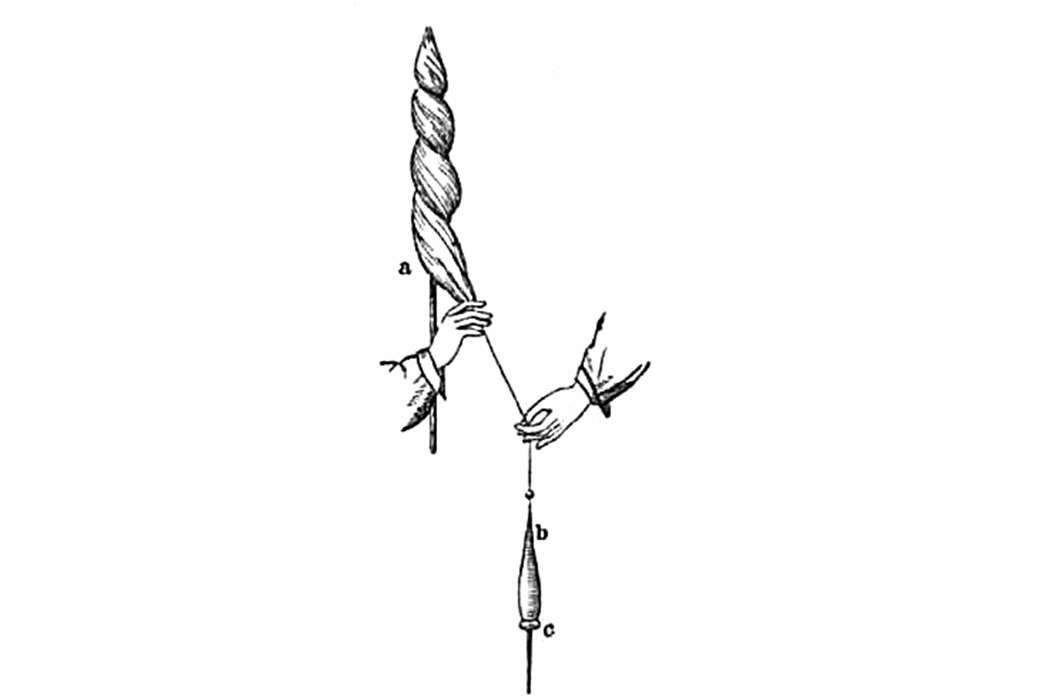
Drop Spindle Diagram. Image via Wikimedia Commons.
Until the invention of the spinning wheel, (probably sometime in the 11th century in Baghdad) the drop spindle was the predominant way of spinning yarn. The weighted whorl (part C of the diagram) was inorganic and often the only part of the spinning and weaving process that survived the ravages of time.
The earliest rugs were made from wool, as nomadic peoples typically herded sheep. These evolved from primitive hides, to flat-weaving: a technique whereby the warp and weft threads are tightly woven to create a flat-surfaced textile with no pile. The textiles we now consider to be Persian rugs feature this characteristic pile: these warp threads that protrude from the base weave, which make up the soft and decorative surface.
None of the textual references to carpets we have now specify whether these pieces were flat–or loop–woven, but likely those lauded for their beauty would have been more like the Pazyryk carpet, the first pile-woven rug that has lasted to modern day.
An Art Form is Born
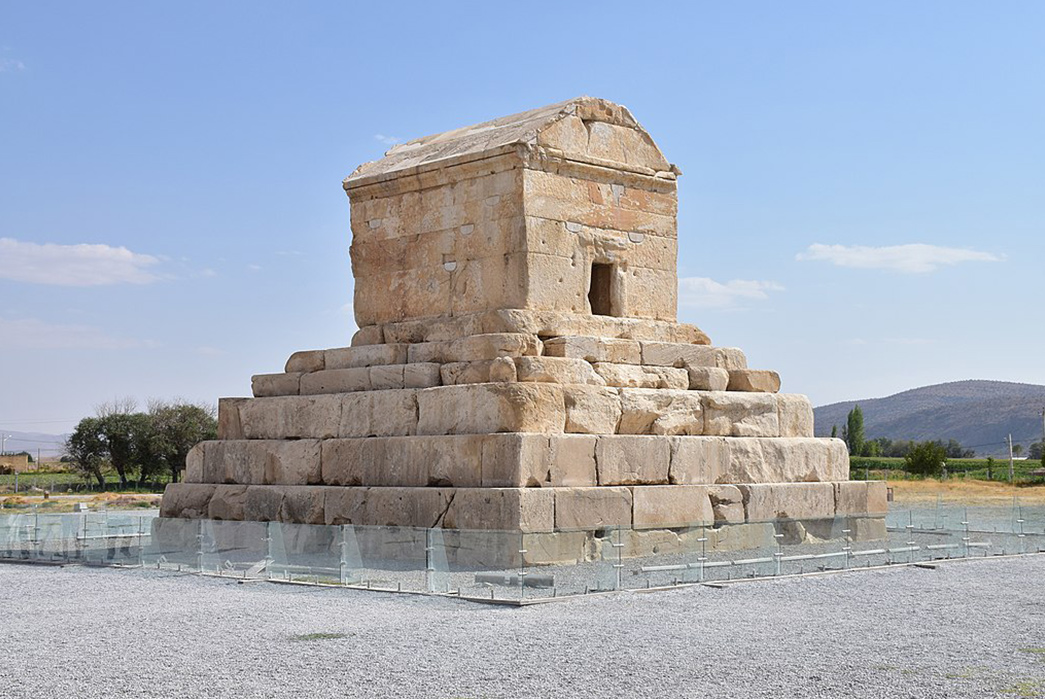
Tomb of Cyrus the Great. Image via Wikipedia.
Some sources speculate that Cyrus the Great’s conquest of Babylon in the 5th Century BCE may have centralized the production of carpets and increased the visibility of the art form, but it’s simply impossible to know for sure. We do know however that Cyrus’ tomb was adorned with fabulous carpets, which leads one to believe that within his lifetime, he was able to make the craft more than a nomadic tradition and encourage a blossoming art form.
The Sasanian Empire, which began in 224 CE and ended in the desecration of the fabulous “Springtime in Khosro” carpet has some of the earliest surviving carpets. The only surviving carpets from the era, forgotten in churches and Tibetan monasteries, often used merely as coverings, were typically flat-woven or embroidered and consequently far less complex.
The Caliphates and the Seljuks
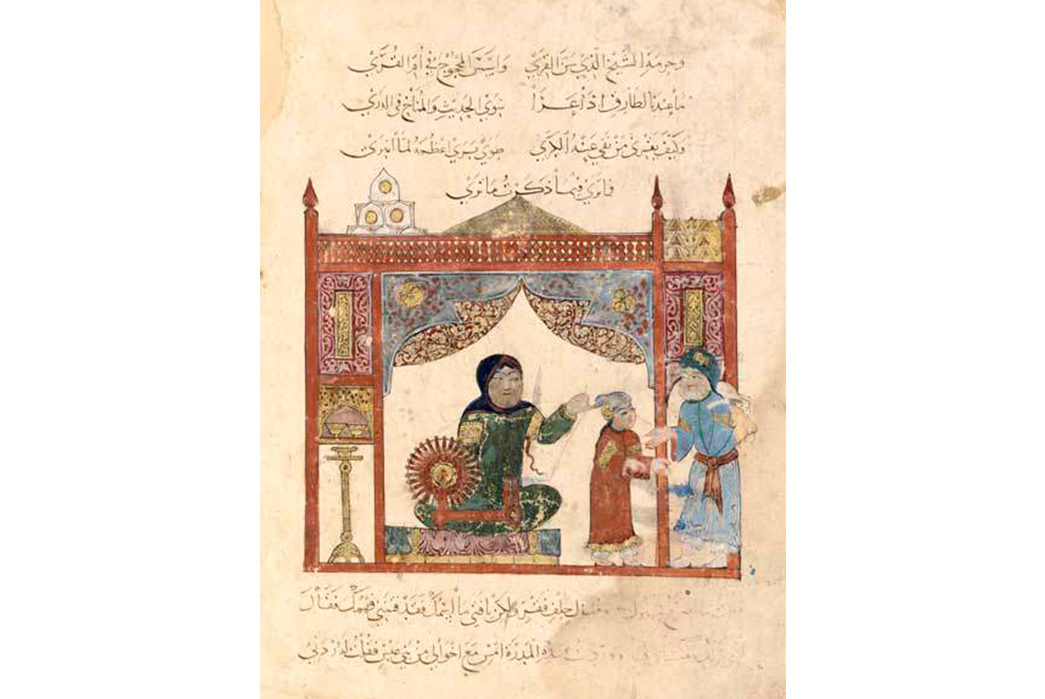
Early illustration of a spinning wheel. Image via Wikipedia.
Under the Sassanids, Zoroastrianism had been the official religion of Persia, but all this changed when Muslim invaders arrived. As mentioned earlier, they sacked Ctesiphon, cutting up and distributing the legendary carpet there, and established Islam as the new religion in the region.
Although this period of dominion didn’t contribute any great changes to the art form, it was around this time that the first spinning wheels were invented in Baghdad. This greatly streamlined the spinning process and marked a change in the textile industry. No longer were nomads walking around, spinning with drop spindles as they went, a stationary spinning wheel was a clear sign of a more professional outlook on making carpets and textiles more generally.
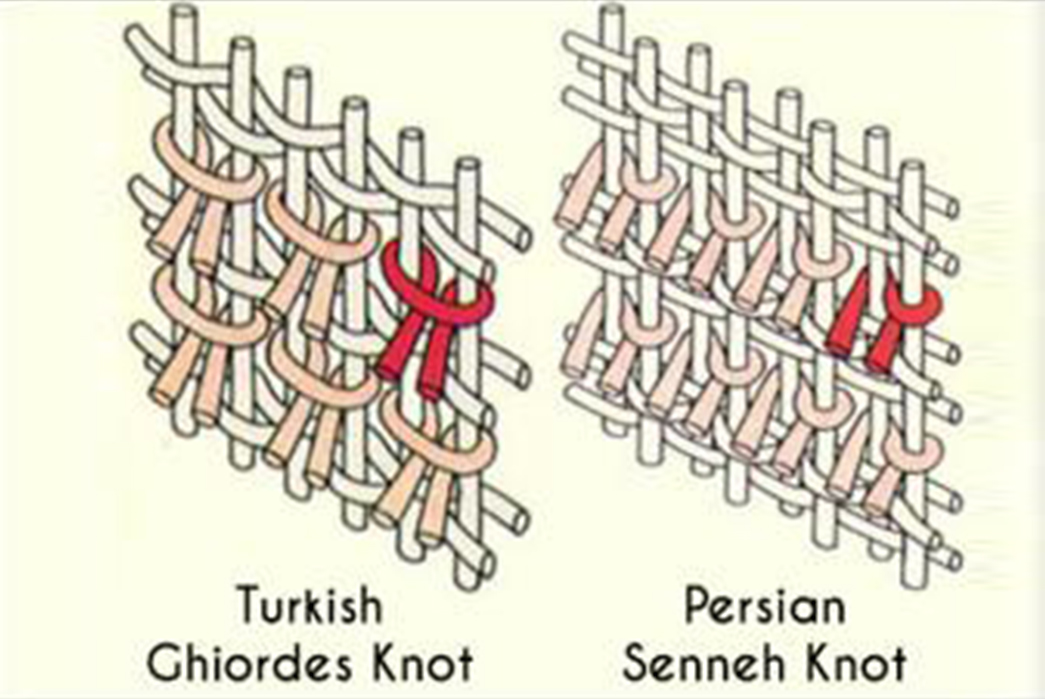
Turkish and Persian Knots. Image via Bosphorus Rugs.
The next wave of invaders were a Turkish tribe known as the Seljuks, who ruled Persia from 1098 to 1194 CE. The information about this period is extremely contradictory, however. What we know for certain is that the Seljuks already had a highly-developed weaving tradition of their own, making pile-woven rugs of their own design, but with a symmetrical knot shown above.
Their knot is supposedly what separates the Turkish and Anatolian tradition of weaving from the Persian one, although some regions of modern-day Iran still use the Turkish knot taught to them hundreds of years ago. Some historians even argue that it was the Seljuk invaders who introduced the concept of pile-woven carpets to the region, which seems to contradict the fact that pieces like the Pazyryk Carpet and other famous pieces originated in the area almost 500 years before.
What is strange is that no distinctly Persian carpets exist from this period, which may indicate that during the Turkish conquest most weavers adopted the Turkish knot, or simply that no examples have survived the ages.
It would have been impossible to monitor the weaving of all groups in the relatively large region we consider to be Persia, so the latter is more likely. What is certain is that the attention to detail and storied weaving tradition certainly had a positive effect on Persian weaving, because the art form was only heightened in the years to come.
The Safavid Dynasty
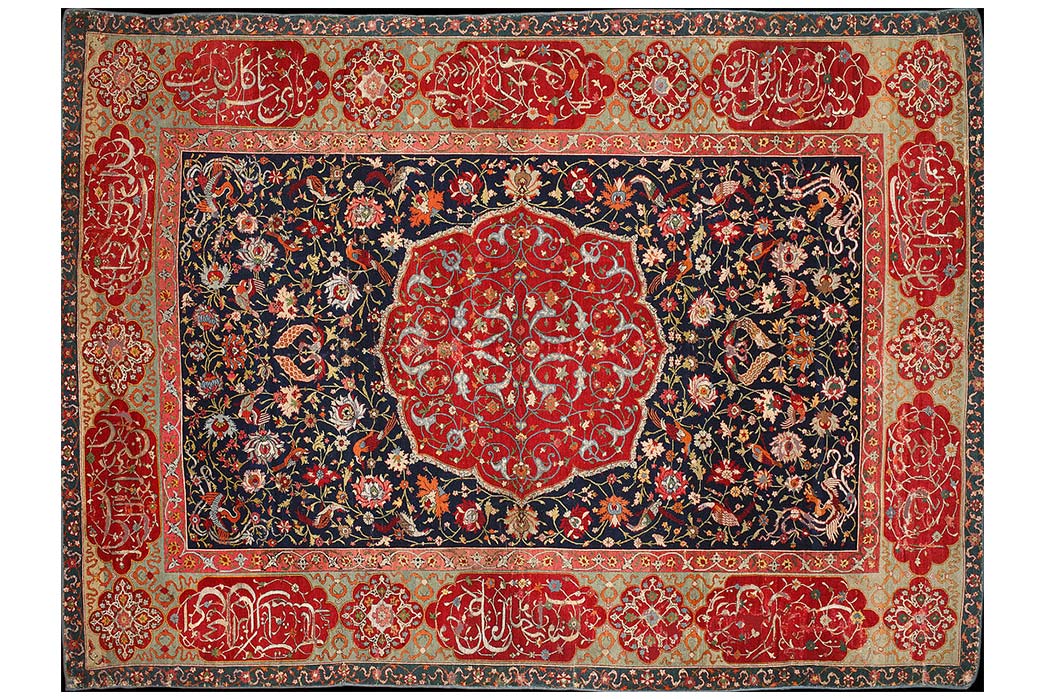
Safavid Rug. Image via Wikipedia.
The Seljuks were eventually ousted by the Mongols, who basically wreaked havoc from 1256-1335, followed by the Timurid Empire, which apparently had beautiful carpets, none of which remain. It wasn’t until the Safavid Empire, which began in 1501, that the historical record begins to fill up with examples of Persian woven artistry.
This new dynasty, was the most stable since the first Arab invasion, and its Shahs became patrons of the arts. Shah Abbas (1587-1629) established weaving workshops and lavishly decorated his new capitol of Isfahan.
For many, this period of state-sponsored creativity marks the height of Persian carpet artistry. The carpets were usually silk and featured precious metal threads like silver and gold. What is shocking is that there are absolutely no surviving examples of the evolution of the craft from many years previous until these masterworks. For this reason, it’s hard to imagine that the Mongols or the Seljuks or any conquerors were able to ever fully stamp out the ever-evolving art form.
Persian Carpet Design
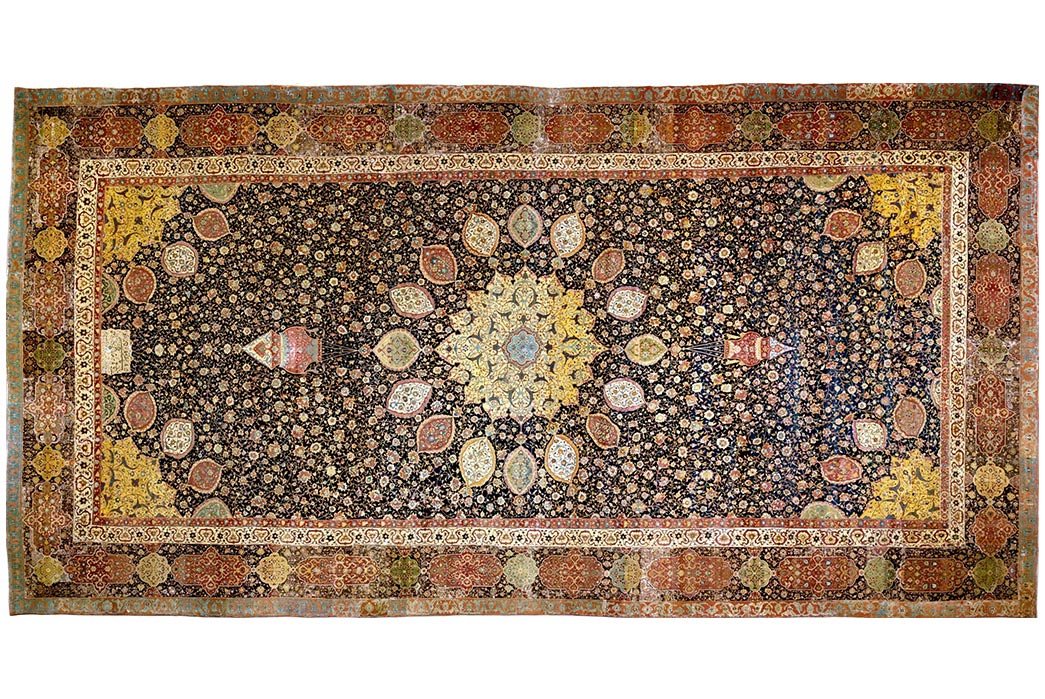
Ardabil Carpet. Image via the Victoria and Albert Museum.
The dramatic florescence of the Persian Carpet in the Safavid period has been labeled by historians as the “Carpet Design Revolution.” The increased presence of curvilinear designs would have entailed a dramatically more complex weaving system than heretofore seen.
Though the Pazyryk Carpet has some gorgeous designs, it’s mostly rectilinear; the carpets of this era have delicate tendrils and arabesques that are far more labor-intensive. The new style of carpet was so complex that artists needed to be commissioned to paint the design, which would then be passed over to weavers, although it’s somewhat unclear how the weavers were able to exactly match these images to the final product.
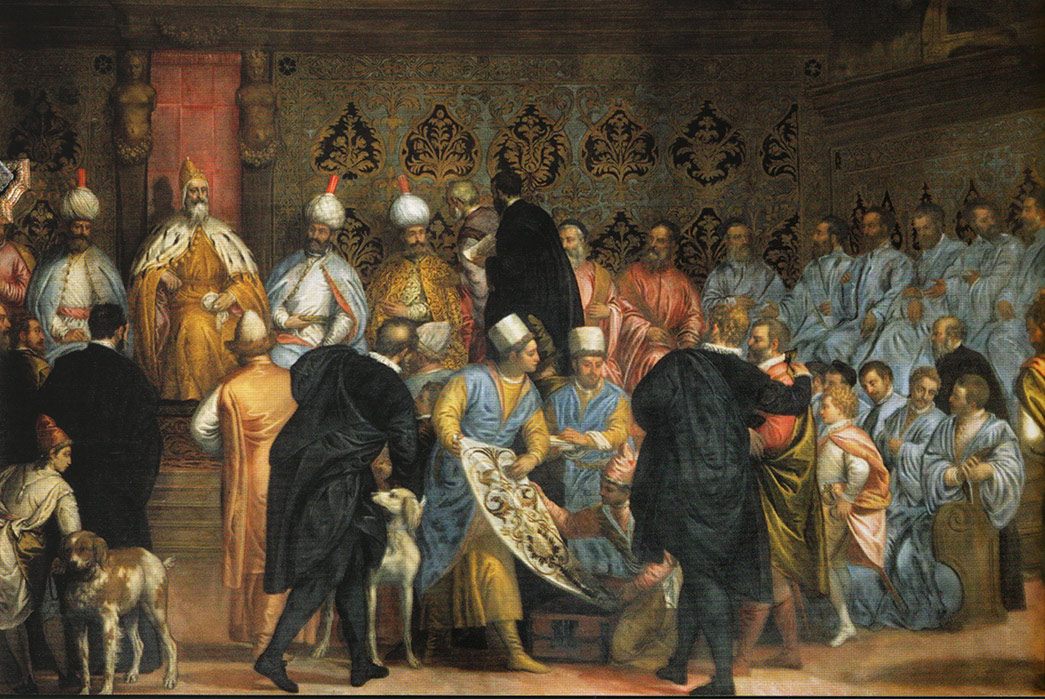
Shah Abbas in Venice. Image via Wikipedia.
For many, the carpets of this period are the be-all end-all. The records from this period are also far more complete so we can get a better grasp of where and for whom these carpets were made. Shah Abbas, the globally-minded ruler of the Dynasty, sent some of his finest carpets to Europe, where they immediately became trendy.
This trade with Europe, specifically with Venice, increased the visibility of the form. Soon, anyone who was anyone wanted one of these gorgeous carpets and the Persian Carpet was introduced to the rest of the world. Though carpets influenced by the Safavid period continued to be made, nothing would match these masterworks, nor would the region experience quite the same degree of patronage from any subsequent ruler.
How It’s Made – Kind of Rugs
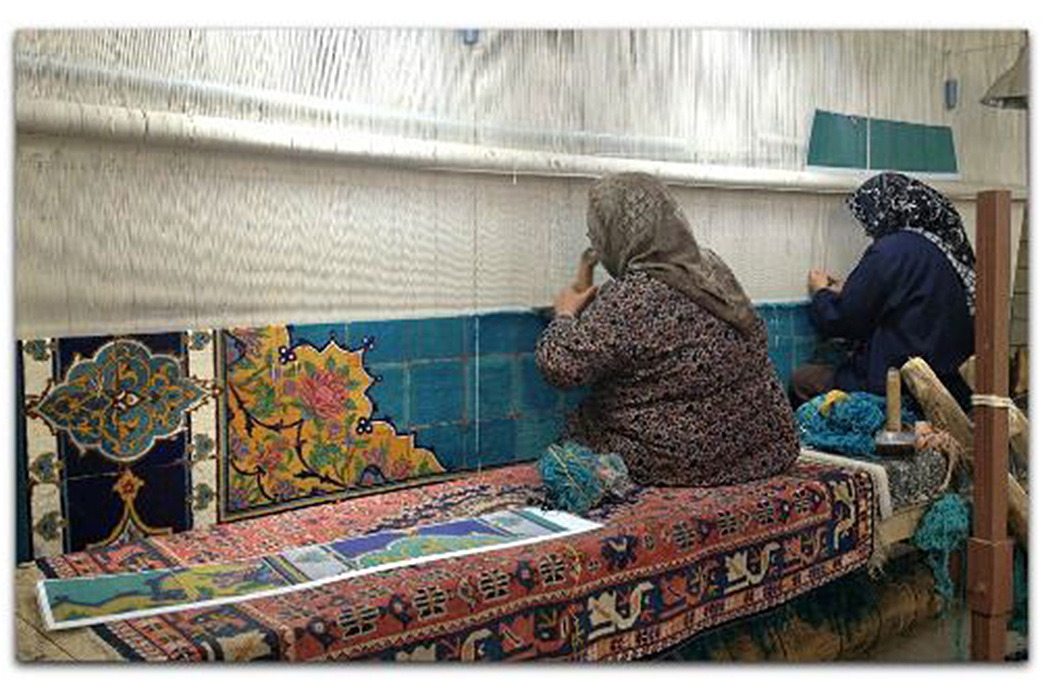
Image via Pinterest.
Weaving one of these intricate pile rugs can take anywhere between months and years. Warps and wefts must first be combined to form the basis of the of the rug. One begins at the bottom of the loom, by passing wefts through the warps, then tying knots of dyed wool, cotton, or silk around sets of these warp threads, these knots ultimately form the pile, and the design of the rug.
Wefts are passed through these rows of knots to secure the pile, then beaten down with a comb to compact the finished row to the rest of the rug. And if this is hard to understand, you and I are absolutely in the same boat, but have a look at the video below and it should clear a few things up:
The style of knot is paramount in identifying the style and origin of the rug. The most common knot in Persian rugs is the asymmetrical Senneh knot, which allows for greater nuance in design and makes it easier to create curvilinear designs than the Turkish knot, which is symmetrical.
A Persian knot doesn’t necessarily make the rug a Persian rug, nor does a Turkish knot make the entire piece Turkish in style. These specialized knots are used in many parts of the world and Turkish knots are also used in Persian rugs.
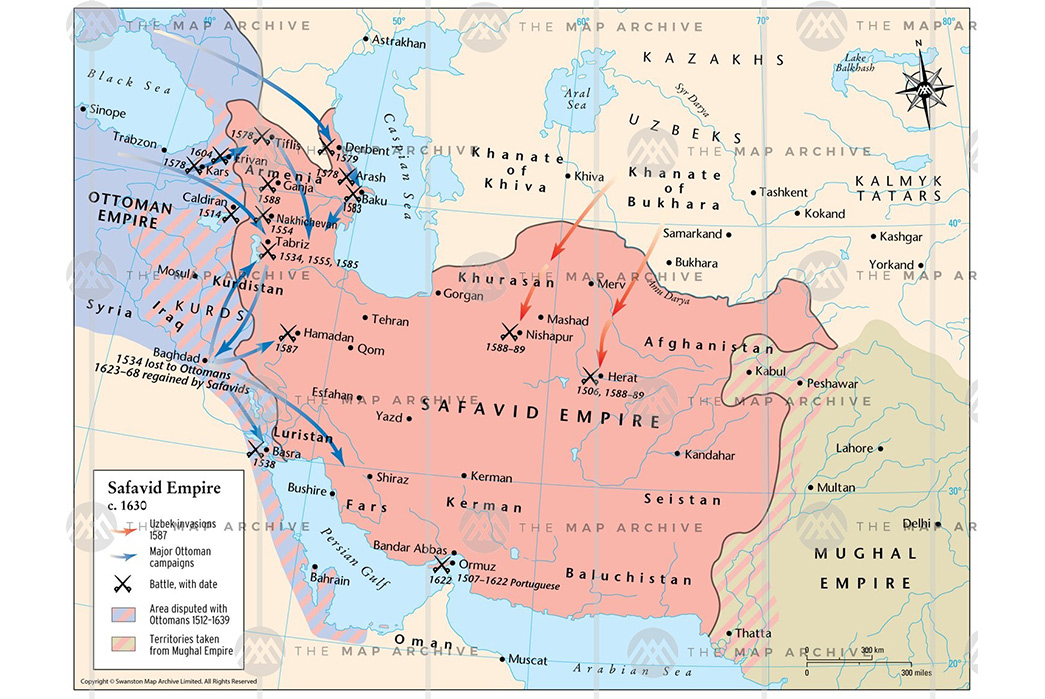
The Safavid Empire.
Though the modern definition of a Persian rug simply means anything woven in modern-day Iran, the original reach of the Persian Empire would have influenced ethnic groups beyond the reach of modern Iran. Because weaving began as a necessity for nomadic groups, there are many, many variations in style depending on region and tribe. These variations are less and less evident, since most nomadic weaving has completely ceased.
Each subregion had differing access to the requisite materials. Goat hair, cottons, dyes, colors of wool; all these factors could differ region to region. There is even variance within certain ethnic groups. For example, Kurdish rugs are so varied in terms of quality and design, it’s hard to make generalizations about any overarching motifs or construction methods.
Some authorities make sweeping classifications by swath of land, but even within certain areas, like those occupied by the Bijar, there are many sub-styles of rug, even if they share some dyes.
Getting Your Own
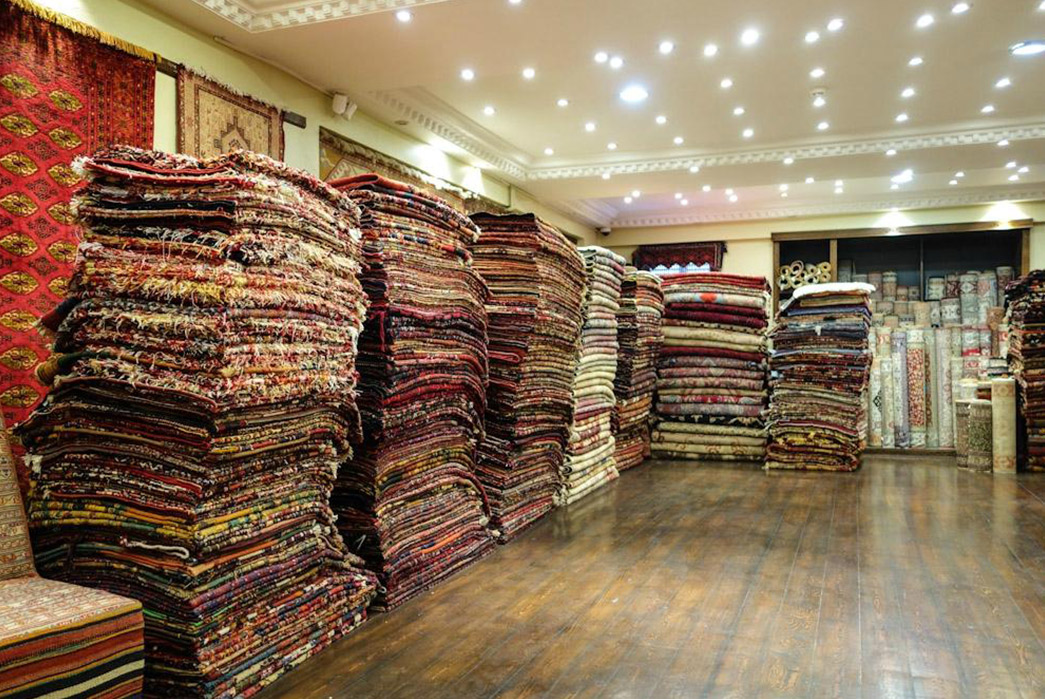
Image via Tripadvisor.
Persian rugs continue to be made in modern-day Iran, but the trade is constantly under fire. Modern, machine-made carpets are far less expensive and sanctions on Iran have hindered the export of these famous pieces. As in many other places in the world, traditional handicrafts are on the decline.
Fewer and fewer artisans are qualified to make these extraordinarily complex pieces and many nomadic peoples struggle to obtain materials of sufficient quality. In 2017, Iran exported around $24 million in carpets once the sanctions were lifted, but other countries, like Turkey, dominate the trade.
If you’re beginning to think about getting your own Persian rug, you’ll want to proceed carefully. There are plenty of websites offering these beauties for several grand, but you’ll likely want to inspect the pieces yourself in person. And because there is such variance in style and quality, even in rugs made in the very same village, you’ll want an expert helping you along the way.
Antique dealers may be the best bet, because those local rug stores that always seem to be closing aren’t super trustworthy. Folks speculate that these stores’ blowout closing sales are actually a scam to move product that is far less valuable than the pricepoint would indicate, much in the same way that department stores calculate for huge markups and markdowns.
Conclusion
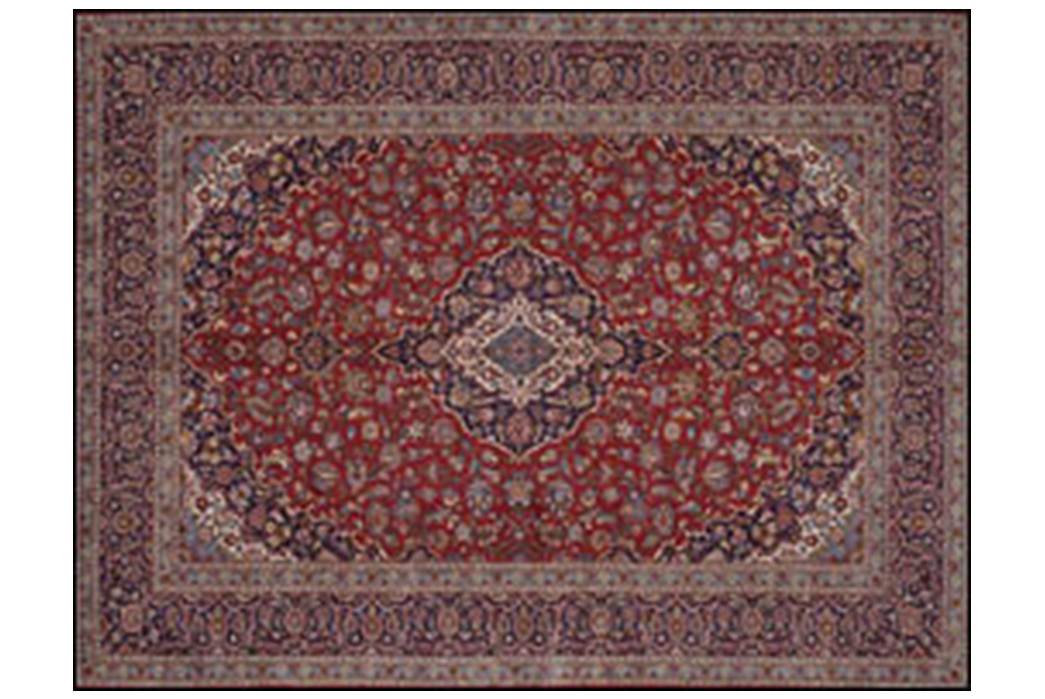
Kashan Carpet. Image via Iran Chamber.
Unlike Navajo Rugs, the history of the Persian Rug is far more diffused across time and distance. Arabesques, medallions, and subtleties in wool color can speak volumes to experts, but may stump the layman.
Like many of our favorite things, the learning curve is steep, but the rewards are priceless. An art form that has survived centuries of upheaval and that has grown and blossomed despite almost no physical historical record; the Persian rug is one of the most impressive crafts made by human hands.

